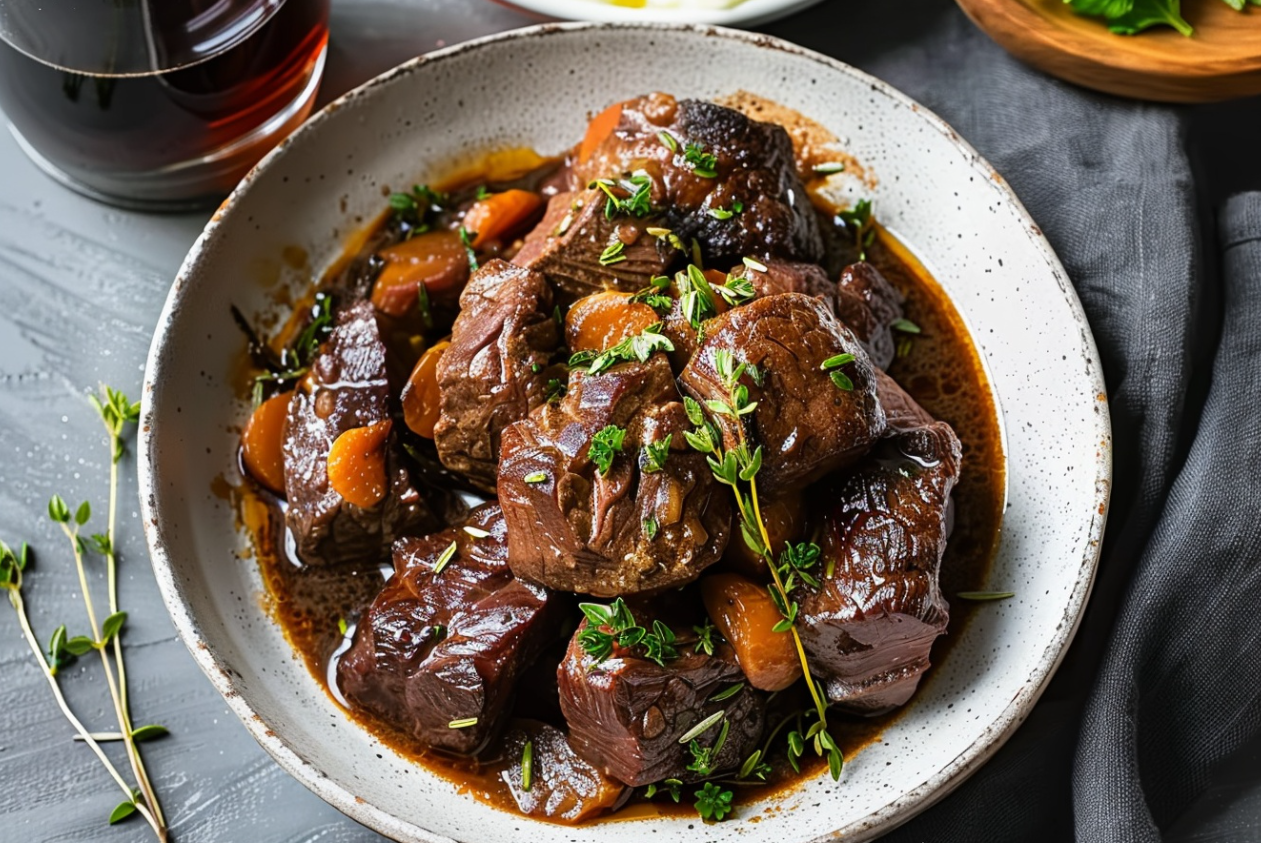Introduction
Braised beef recipe is a timeless culinary delight, loved for its rich flavor and tender texture. This classic dish, which involves slow-cooking beef in liquid, has been a favorite in kitchens around the world for generations. Braised beef is a fail-safe option, ideal for both special celebrations and cozy family dinners.
Objective
This article aims to serve as a detailed guide to crafting the ultimate braised beef. You’ll learn everything from the basic recipe to advanced techniques and tips for maintaining the dish’s quality. By the conclusion of this guide, you will possess the skills necessary to prepare a succulent dish that’s sure to captivate even the most sophisticated taste buds.
Overview
In this guide, we’ll start with a classic braised beef recipe that you can master easily. For those looking to elevate their cooking, advanced techniques and flavor enhancements will be covered. Additionally, we’ll provide advice on how to maintain your braised beef so it remains fresh and flavorful. Additionally, we’ll explore dietary adaptations to suit various needs and answer common FAQs.
For a detailed recipe on how to make braised beef, you can check out this comprehensive guide on Simply Recipes. If you’re looking for expert tips and a step-by-step process, this recipe from Food Network is highly recommended.
As we dive into the art of braised beef, you’ll find that it’s a versatile dish that allows for creativity and personal touches. Using the appropriate ingredients and methods, you can elevate a basic beef cut into an exquisite culinary experience. Whether you’re a seasoned cook or a beginner, this guide will provide valuable insights to help you perfect your braised beef recipe.
Basic Braised Beef Recipe
Print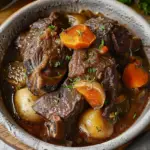
Classic Braised Beef
- Total Time: 3 hours 20 minutes
- Yield: 6 servings 1x
- Diet: Gluten Free
Description
This classic braised beef recipe is the epitome of comfort food, delivering rich flavors and tender meat with every bite. Perfect for a family dinner or a special occasion, it promises to be a crowd-pleaser.
Ingredients
- 3 ½ pounds boneless beef chuck roast
- 5 teaspoons kosher salt, divided
- 2 ½ teaspoons freshly ground black pepper, divided
- 2 teaspoons garlic powder
- 4 teaspoons olive oil
- 2 tablespoons butter
- 1 medium onion, chopped
- 1 pound cremini mushrooms, halved
- 3 medium carrots, cut into 2-inch pieces
- 1 head garlic, cut in half lengthwise
- 1 cup red wine
- 3 sprigs thyme
- 2 bay leaves
- 2 teaspoons Worcestershire sauce
- 2 cups beef broth, or more as needed
- 2 tablespoons chopped fresh parsley
Instructions
- Preheat your oven to 325°F (163°C).
- Season the beef with 3 teaspoons of salt, 1 ½ teaspoons of pepper, and garlic powder.
- Heat olive oil and butter in a large Dutch oven over medium-high heat. Brown the beef on all sides.
- Remove the beef and set aside. In the same pot, sauté the onion, mushrooms, and carrots until soft.
- Add the halved garlic, red wine, thyme, bay leaves, Worcestershire sauce, and beef broth. Bring to a simmer.
- Return the beef to the pot. Cover and transfer to the oven. Braise for 2 ½ to 3 hours, or until the beef is tender.
- Remove the beef and let it rest before slicing. Garnish with chopped parsley.
Notes
- For a deeper flavor, consider marinating the beef overnight.
- Check the liquid level occasionally, adding more broth if necessary.
- Prep Time: 20 minutes
- Cook Time: 3 hours
- Category: Main Course
- Method: Braising
- Cuisine: American
Nutrition
- Serving Size: 1 serving
- Calories: 520 kcal
- Sugar: 2g
- Sodium: 1200g
- Fat: 35g
- Saturated Fat: 14g
- Unsaturated Fat: 16g
- Trans Fat: 0g
- Carbohydrates: 7g
- Fiber: 2g
- Protein: 40g
- Cholesterol: 130mg
Keywords: braised beef
For a detailed recipe and more cooking tips, you can explore this guide on Simply Recipes. Additionally, Food Network’s ultimate braised beef recipe offers step-by-step instructions and expert advice.
STEPS
Step 1
Collect all the necessary ingredients and set your oven to preheat at 350 degrees Fahrenheit (175 degrees Celsius).
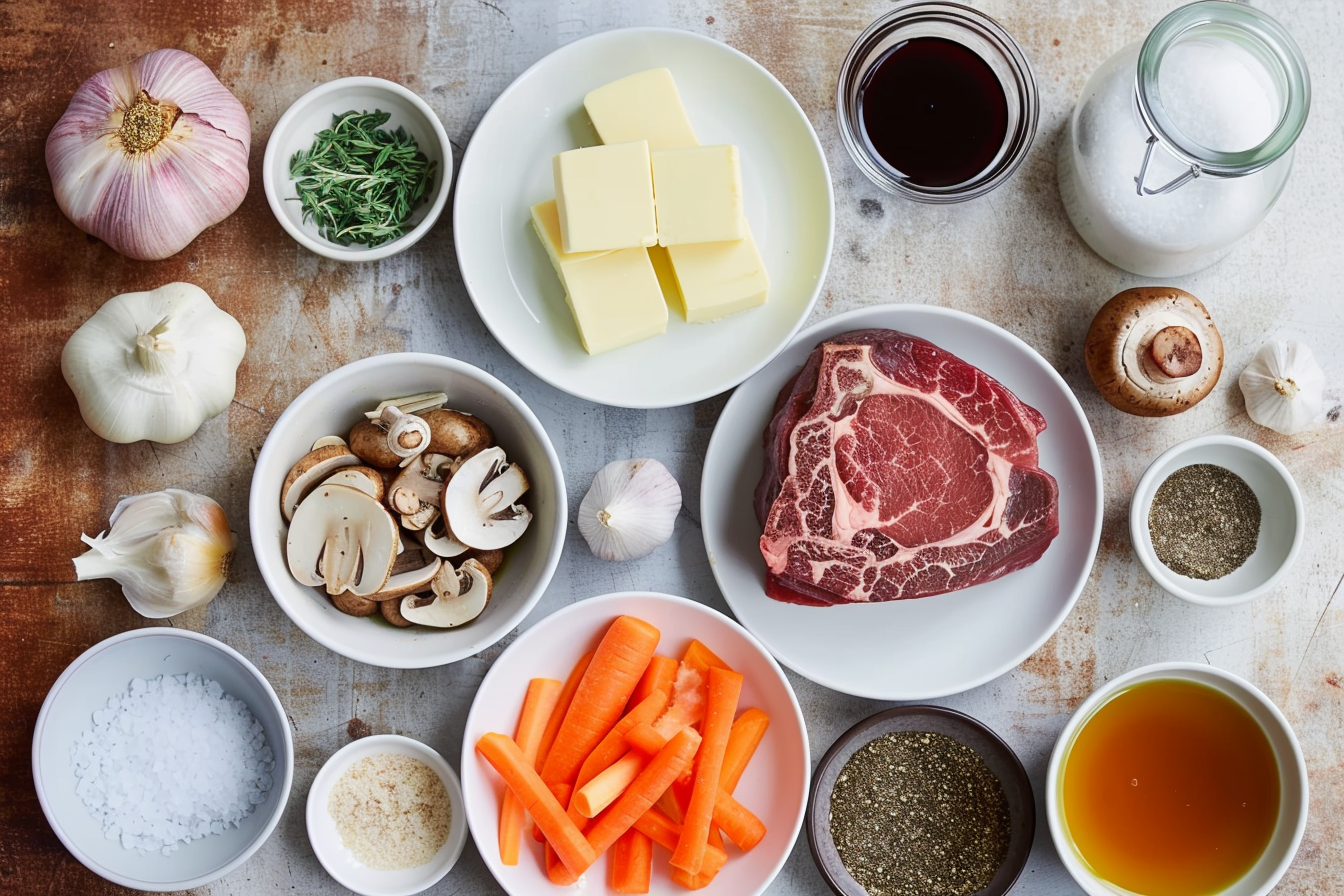
Step 2
Evenly coat the beef pieces on all sides with 3 1/2 teaspoons of salt, 2 teaspoons of pepper, and garlic powder.
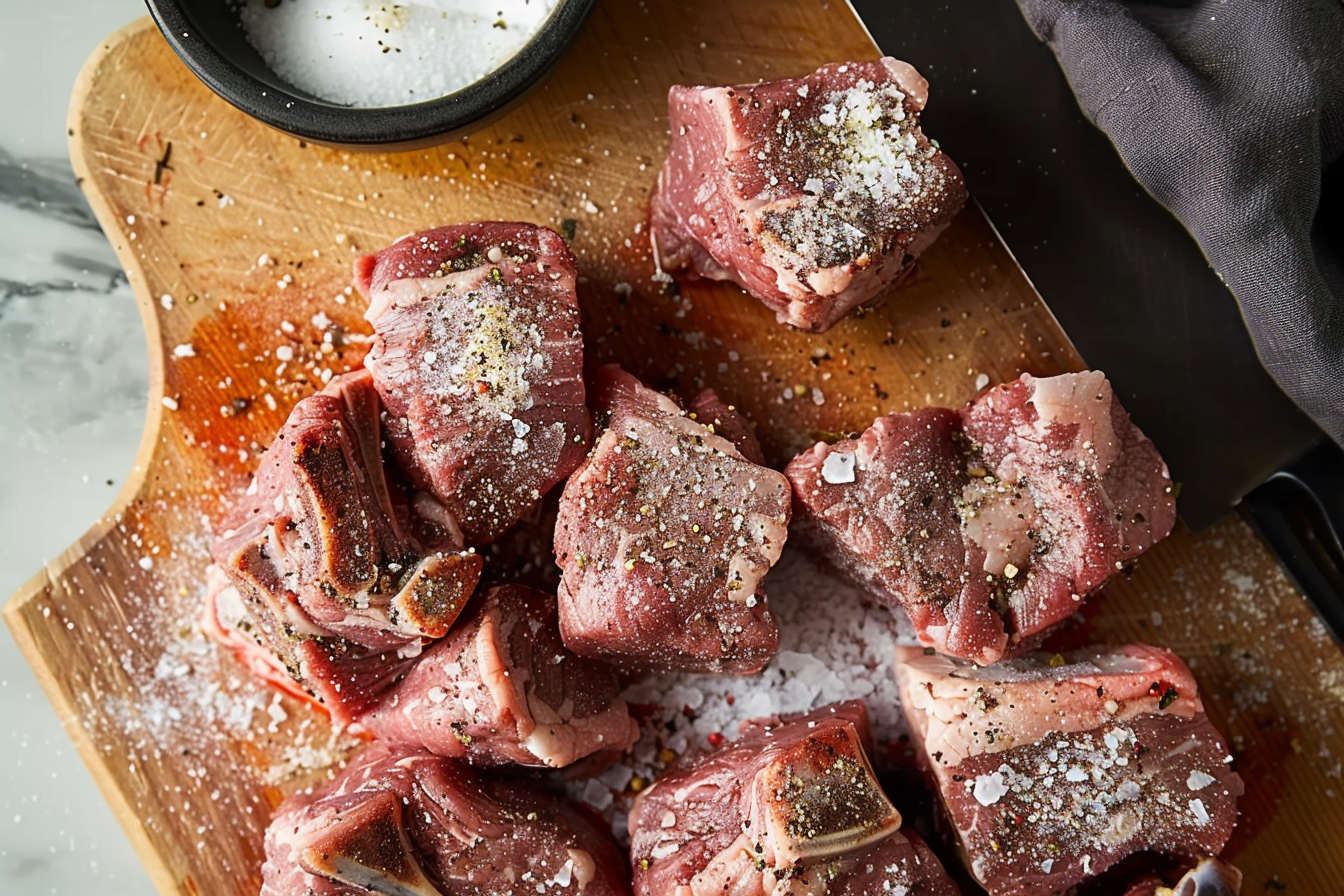
Step 3
Warm oil in a sizable skillet over high heat. Place the beef in the pan, then lower the heat to medium-high and allow it to sear undisturbed until it loosens easily and achieves a golden-brown crust, roughly 4 minutes. Turn the beef over and sear until it is browned on all sides. Then, take the meat out of the pan and set it aside.

Step 4
Reheat the skillet to medium-high and stir 2 tablespoons of butter into the pan drippings. Once the butter melts, toss in the onions, mushrooms, and carrots, cooking for 5 minutes while frequently stirring and scraping up any browned bits from the bottom of the pan. Then add the garlic and continue cooking for an additional minute.
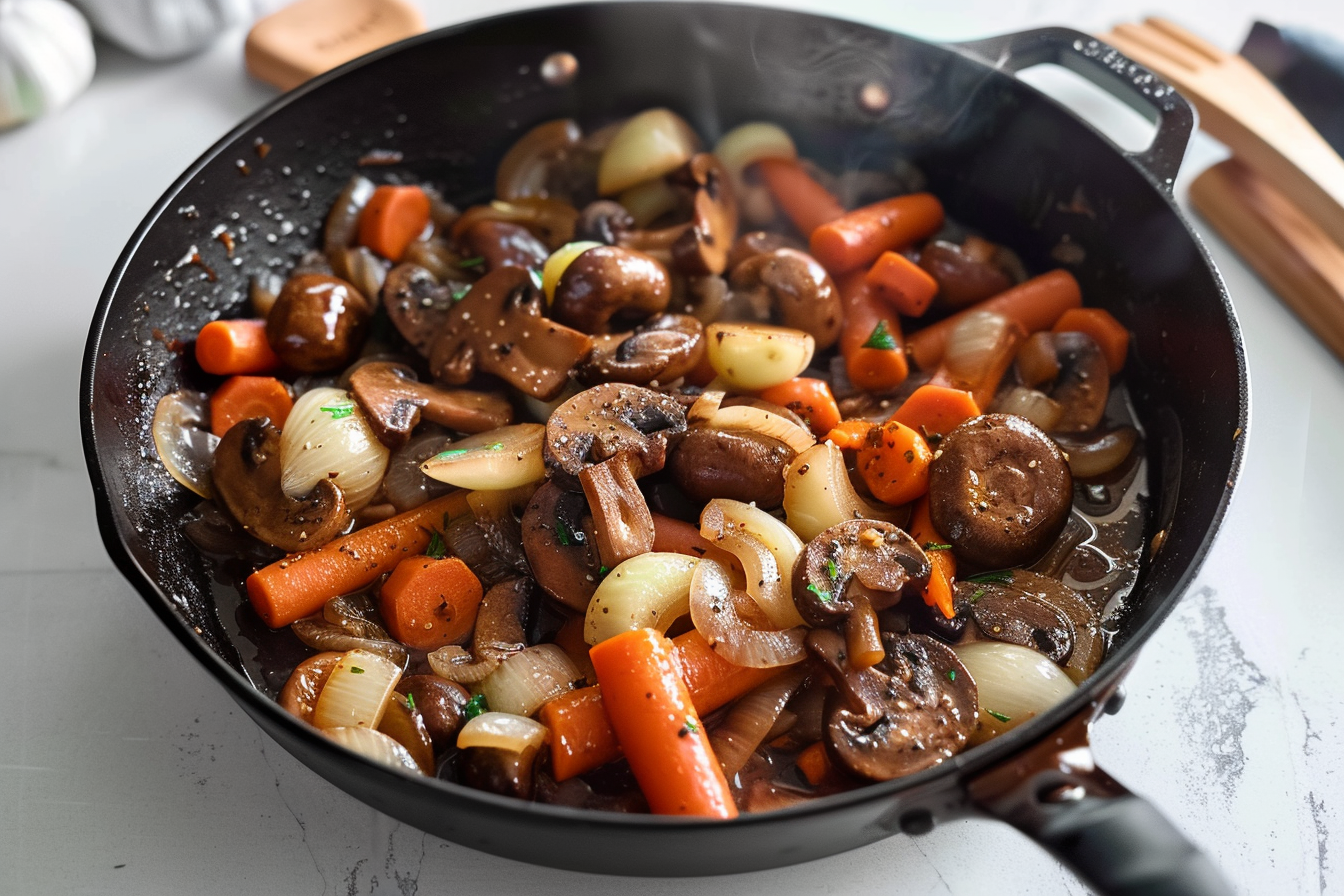
Step 5
Pour in the wine and deglaze the pan, scraping up any remaining bits. Reintroduce the beef to the skillet, including any juices that have collected, and mix in thyme, bay leaves, and Worcestershire sauce.
Step 6
Add beef broth to the skillet, filling it so that the liquid reaches about two-thirds of the way up the beef pieces—be careful not to submerge the meat completely. Then, bring the mixture to a gentle simmer.

Step 7
Cover the skillet and transfer it to the preheated oven, allowing the meat to cook until it becomes extremely tender, approximately 2 to 2 1/2 hours.
Step 8
Serve and enjoy.
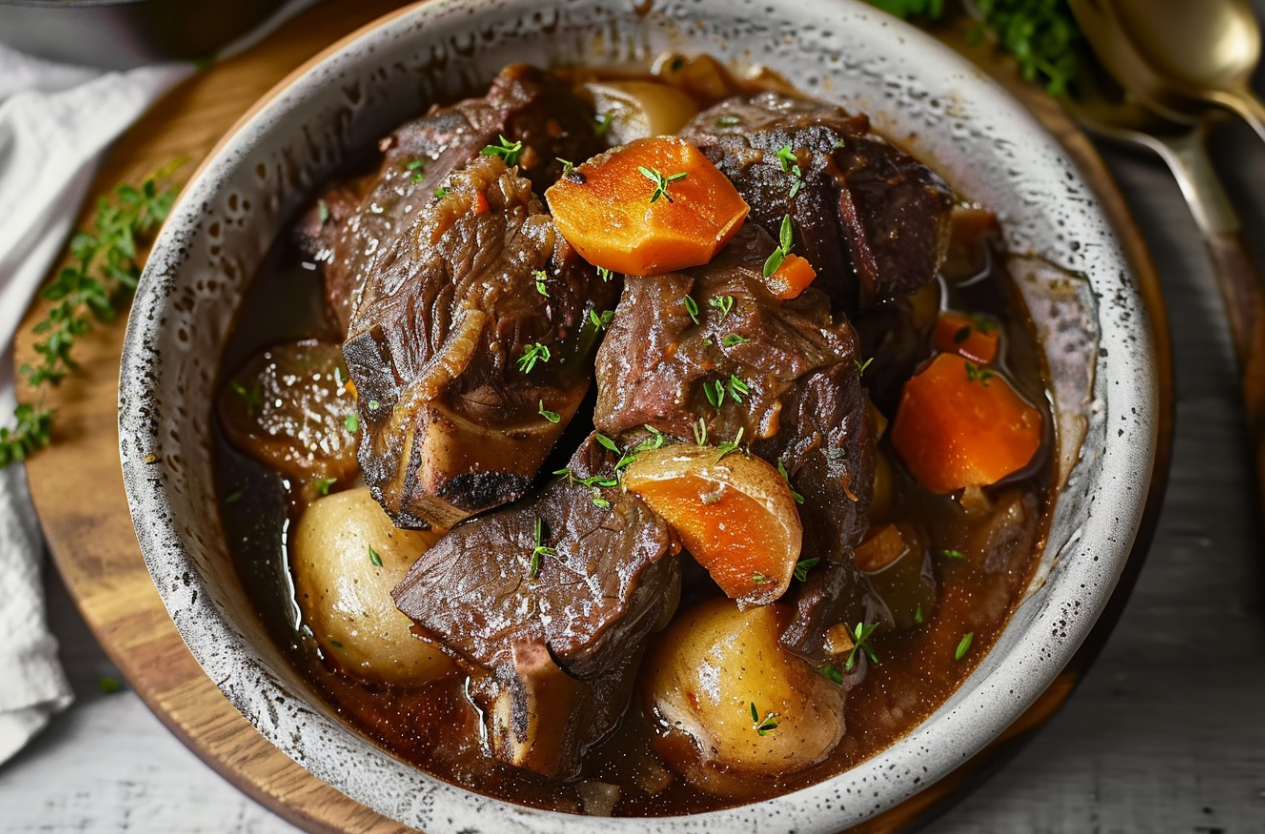
Advanced Techniques and Tips
Choosing the Right Cut of Beef
Selecting the appropriate cut is crucial for achieving perfect braised beef recipe. Opt for cuts like chuck, brisket, or short ribs, as they are ideal for slow cooking. These cuts, rich in fat and connective tissue, succumb to the slow-cooking alchemy, yielding tender, savory delights. When choosing beef, look for well-marbled pieces. The marbling enhances the flavor and texture, ensuring your braised beef is rich and succulent.
Enhancing Flavor
To elevate the flavor of your braised beef, consider marinating the meat beforehand. A marinade with ingredients like red wine, garlic, and herbs can infuse the beef with additional depth. Extend an invitation for the meat to luxuriate in its marinade, overnight for optimal enchantment.
Incorporating liquids such as wine, stock, or even beer into your braising liquid can also enhance the flavor. The elixirs of broth and wine bestow complexity and opulence upon the dish. Additionally, consider adding a splash of balsamic vinegar or soy sauce for a unique twist.
Cooking Equipment
Using the right equipment is essential for successful braised beef. A robust, oven-safe vessel like the Dutch oven, serves as the ideal crucible, ensuring uniform heat distribution and moisture retention. It’s the guardian of succulence, preserving the meat’s tenderness amidst the cooking fray. Alternatively, relinquish control to the slow cooker for a hands-off, yet equally enchanting, rendition.
Temperature control is vital during the braising process. A gentle, unwavering heat ensures the beef surrenders to tenderness without surrendering to overcooking. The slow, melodic dance of flavors meld together in a harmonious crescendo.
Unlock the realm of culinary mastery by embracing these nuanced techniques, elevating braised beef to celestial heights. Remember, choosing the right cut of beef, enhancing the flavor with marinades and liquids, and using proper cooking equipment are key to achieving a delicious and tender dish. Delve into the realm of experimentation, sculpting your own masterpiece of braised beef. Discover more advanced recipes
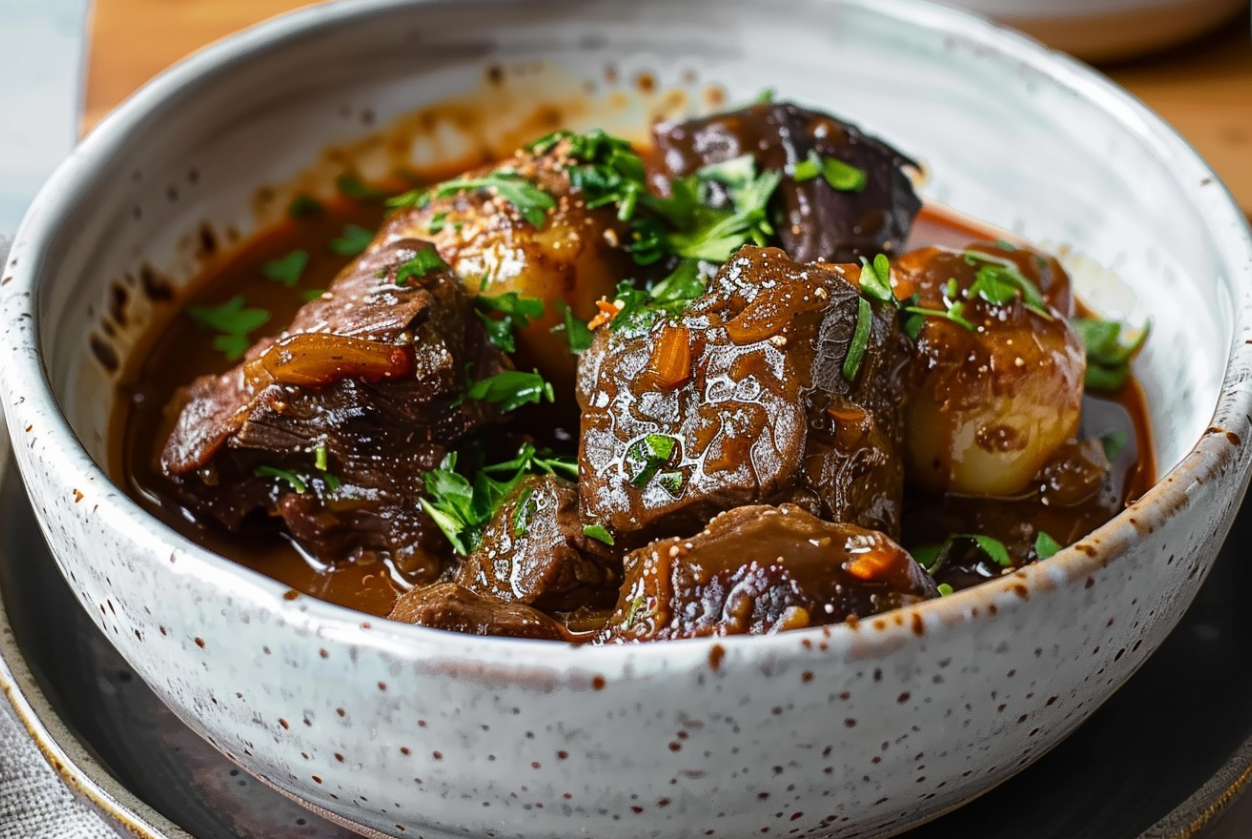
Maintenance and preservation guidelines stand as sentinels, guarding the dish’s integrity.
Proper Storage Methods
Ensuring the adept preservation of braised beef is imperative for upholding its flavor and texture. Once cooled, usher the beef into an airtight sanctuary, safeguarding its succulence. Refrigerate for up to four days, or liberate it into the icy embrace of the freezer for extended longevity. Place the braised beef in a freezer-safe container or heavy-duty freezer bag. Banish the specter of freezer burn by purging excess air before sealing. Labeling with dates ensures a roadmap to culinary bliss, guiding the meat’s voyage for up to three months.
Reheating Braised Beef
Reheating braised beef correctly ensures it retains its tenderness and rich flavor. For the best results, reheat it slowly. Place the beef and its sauce in a covered oven-safe dish. Reheat in a preheated oven at 325°F (165°C) until warmed through, typically about 20-30 minutes. Resurrect the beef on the stovetop, nurturing it with occasional stirrings, eschewing the uneven embrace of the microwave. Beware the microwave’s capricious touch, which may usher toughness upon the tender. Should the need arise, bestow a gentle baptism of beef broth or water to maintain moisture levels.
Leftover Ideas
Repurposing residual braised beef opens the door to an array of delectable culinary creations. Allow me to present some inventive suggestions:
- Braised Beef Tacos: Embrace the braised beef’s transformation into tantalizing tacos, adorned with fresh salsa and creamy avocados.
- Beef Sandwiches: Pile the beef on a crusty roll with your favorite condiments and some pickled vegetables.
- Beef and Vegetable Soup: Add the beef to a pot of simmering broth with assorted vegetables and some pasta or rice.
- Beef Stew: Combine the leftover beef with root vegetables and simmer until everything is tender and the flavors meld together.
Through meticulous adherence to storage and reheating rituals, braised beef reigns supreme across successive meals. Experiment with different leftover ideas to keep your meals exciting and varied.
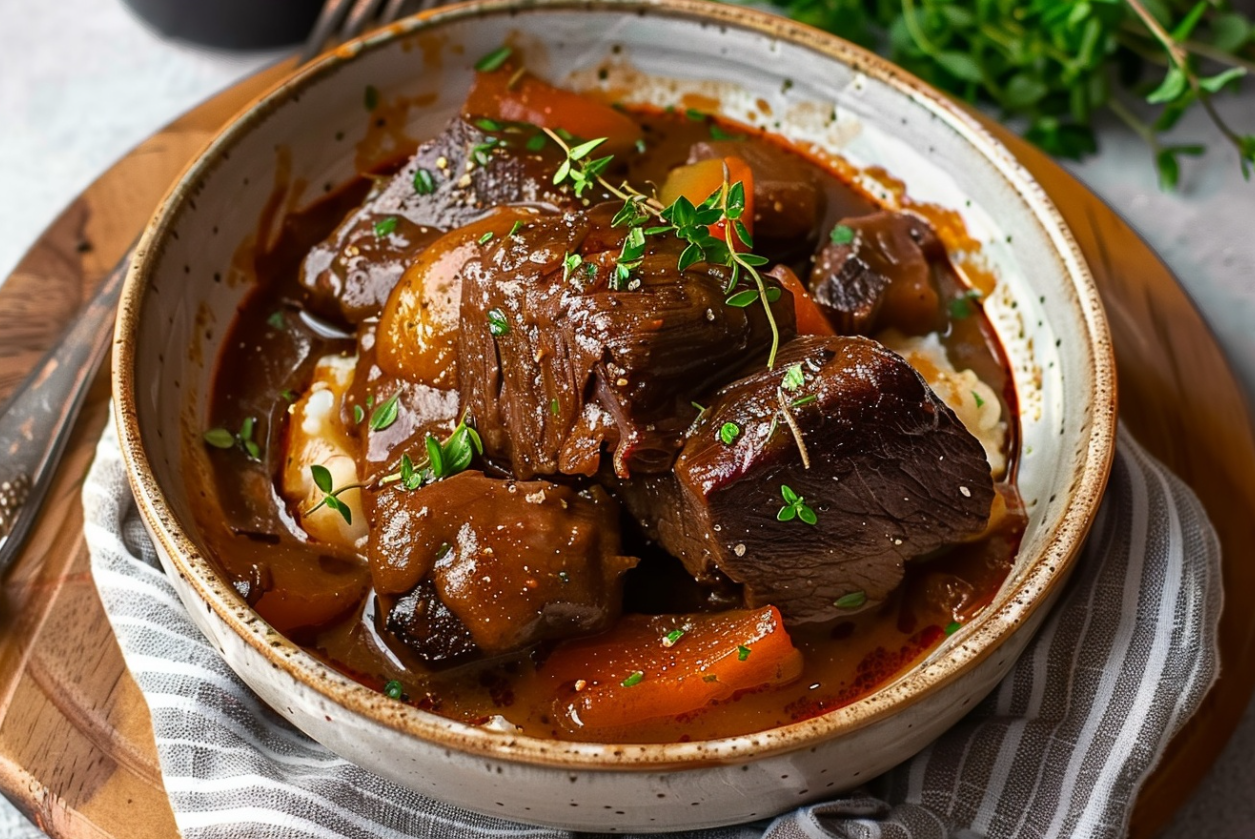
Dietary Adaptations and Variations
Healthier Versions
Creating a healthier version of braised beef recipe is possible by making a few adjustments. Opt for leaner cuts to sculpt a healthier rendition of this culinary classic. Opt for low-sodium broth and reduce the amount of added salt to control sodium levels. Replace traditional cooking oils with heart-healthy options like olive oil. Additionally, incorporating more vegetables can enhance the nutritional value without compromising flavor. Consider adding mushrooms, bell peppers, or zucchini to the braising mix.
Diet-Specific Modifications
Catering to the diverse palates of discerning gourmands. For a keto-friendly version, avoid adding starchy vegetables like potatoes or carrots. Instead, use low-carb vegetables such as cauliflower and green beans. For a paleo adaptation, ensure all ingredients are whole and unprocessed, and use bone broth instead of regular beef broth. To make the dish gluten-free, use gluten-free broth and verify that all seasonings and sauces are gluten-free as well.
For a vegetarian or vegan twist, replace the beef with hearty vegetables or plant-based proteins. Large portobello mushrooms, jackfruit, or tofu can be excellent substitutes. Use vegetable broth and the same braising technique to achieve a rich, savory dish without meat.
International Variations
Braised beef recipes vary widely across different cultures, offering unique flavors and techniques. Channel the spirit of French gastronomy with the timeless elegance of boeuf bourguignon, a red wine-braised symphony. Italian brasato al Barolo uses Barolo wine and often includes root vegetables and aromatic herbs.
Asian variations include Chinese hong shao niu rou, where the beef is braised with soy sauce, ginger, and star anise, giving it a deep, aromatic flavor. In Korean cuisine, galbi jjim features braised short ribs cooked with soy sauce, garlic, and a hint of sweetness from honey or sugar. Latin American recipes might include ropa vieja, a Cuban dish where the beef is braised with tomatoes, bell peppers, and spices, then shredded and served with rice.
Exploring these international variations can bring new dimensions to your braised beef repertoire. Each version offers distinct flavors and ingredients, allowing you to experience global culinary traditions from your kitchen.
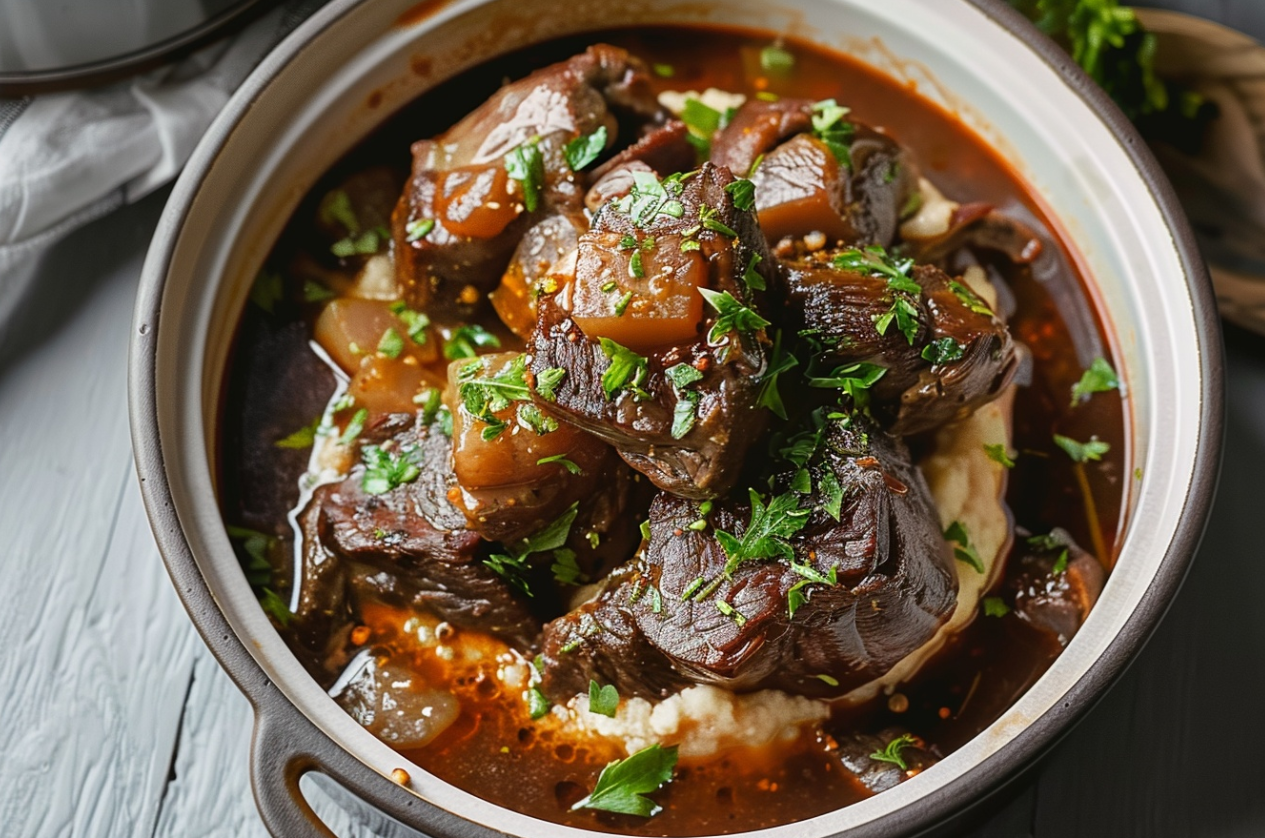
FAQs about Braised Beef Recipe
Common Questions
What is the best way to braise beef?
The best way to braise beef is to follow a few key steps. Begin the saga with a judicious selection of beef cuts, primed for the slow-cooking odyssey. Kindle a rich, caramelized tapestry by initiating the beef’s journey with a tantalizing sear. Then, cook the beef in a flavorful liquid like beef broth or red wine, along with aromatics like garlic, onions, and herbs. Cloak the pot, nurturing the beef’s metamorphosis over a gentle, flavor-infused simmer.
What cut of beef is used for braised beef Recipe?
The most commonly used cuts for braised beef are those with ample connective tissue and fat, which break down during the long cooking process, resulting in tender, flavorful meat. Popular choices include chuck roast, brisket, short ribs, and shank. These cuts benefit greatly from the slow cooking method, which transforms tougher meats into succulent, melt-in-your-mouth dishes.
What is the best liquid for braising beef?
The alchemy of braising liquid conjures a symphony of succulence and flavor. Beef broth is a classic choice, providing a rich, savory base. Red wine is another popular option, lending a deep, complex flavor that enhances the beef. Other suitable liquids include beer, which adds a unique malty taste, and tomato-based sauces for a tangy twist. A combination of these liquids can also be used to create a more nuanced flavor profile.
What does it mean to braise beef?
To braise is to orchestrate a slow, tantalizing ballet of flavors and textures. This method combines both dry and moist cooking techniques. First, the beef is seared in hot oil to develop a flavorful crust. Then, it is simmered in liquid, covered, for an extended period. Through the crucible of slow-cooking, beef emerges tender, its essence suffused with the elixir of braising. Braising is ideal for tougher cuts of meat, as it breaks down the connective tissue, resulting in a dish that is both flavorful and tender.
These tips and answers should help you master the art of braising beef, ensuring that your dishes are always rich, tender, and full of flavor. Whether you’re a seasoned cook or a beginner, understanding these basics will enhance your culinary skills and make your braised beef a standout dish.
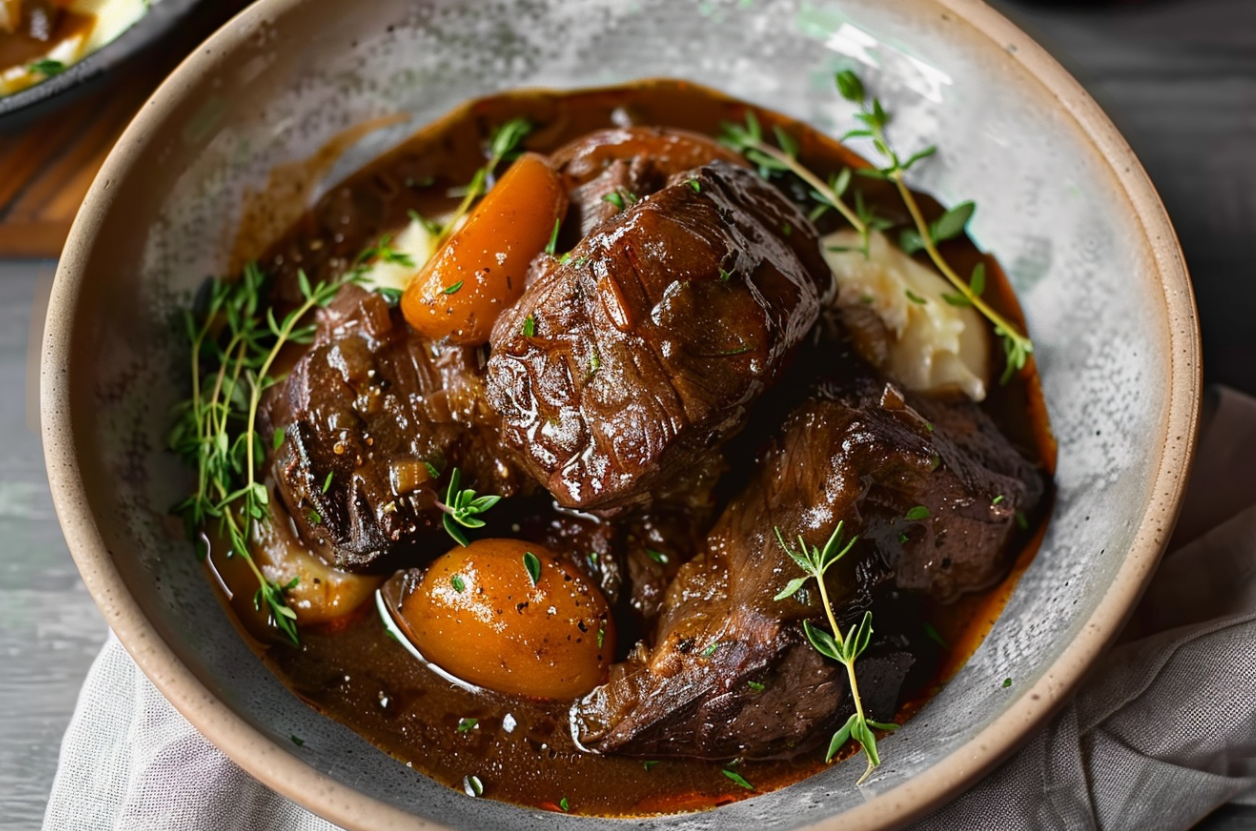
Conclusion
Recap of Key Points
In summary, mastering braised beef involves understanding the importance of choosing the right cut, enhancing flavors with marinades and braising liquids, and using proper cooking equipment. Adherence to these rituals yields a dish at once tender and teeming with flavor. Braised beef is a versatile recipe that can be adapted to suit various dietary needs and preferences, making it a valuable addition to your culinary repertoire.
Inspiration for Exploration
Embrace the spirit of exploration! Feel empowered to venture into uncharted culinary territories, experimenting freely with diverse ingredients and techniques. Each attempt at making braised beef will enhance your understanding and skill. Whether you’re adjusting the seasoning, trying a new type of braising liquid, or exploring different serving options, each variation adds to your culinary experience.
By applying these tips and techniques, you’ll be well on your way to creating braised beef that is not only delicious but also tailored to your personal taste. Enjoy the process of making this comforting and satisfying dish, and share it with family and friends to make memorable meals together.

